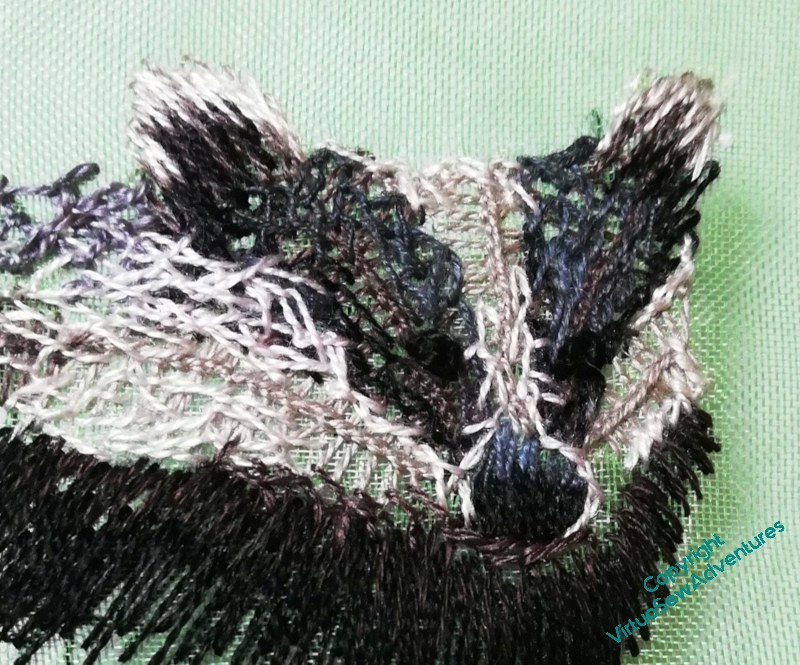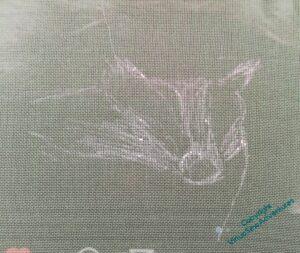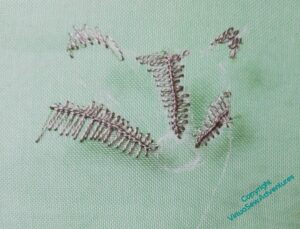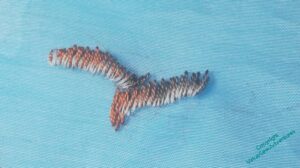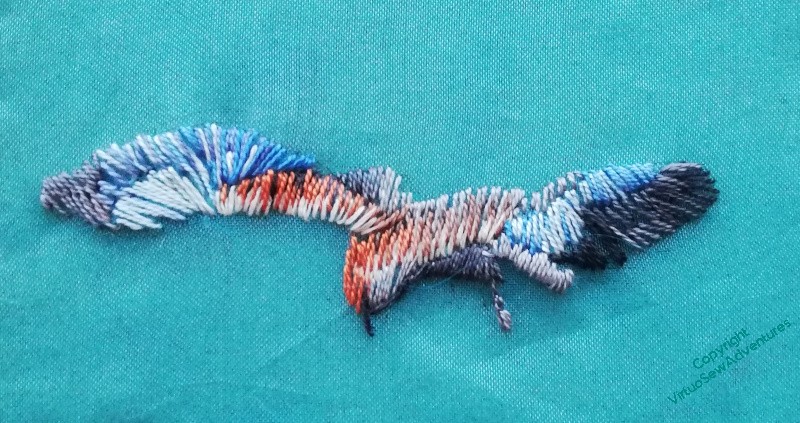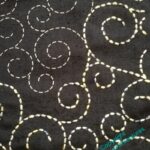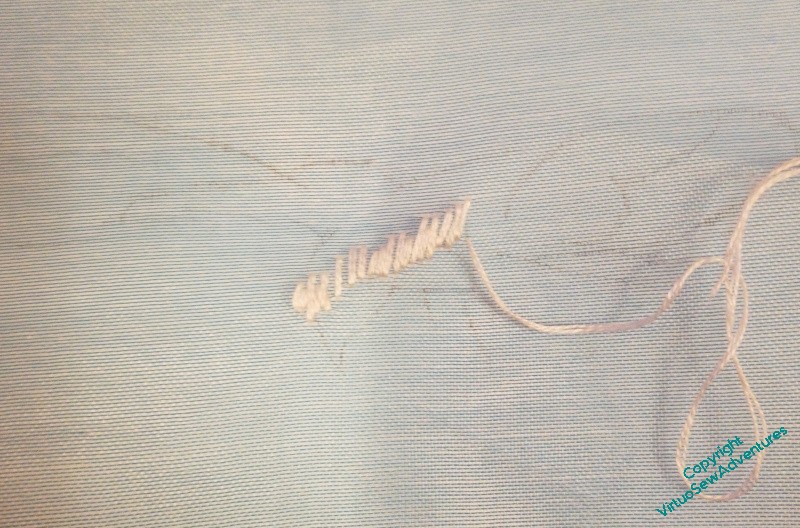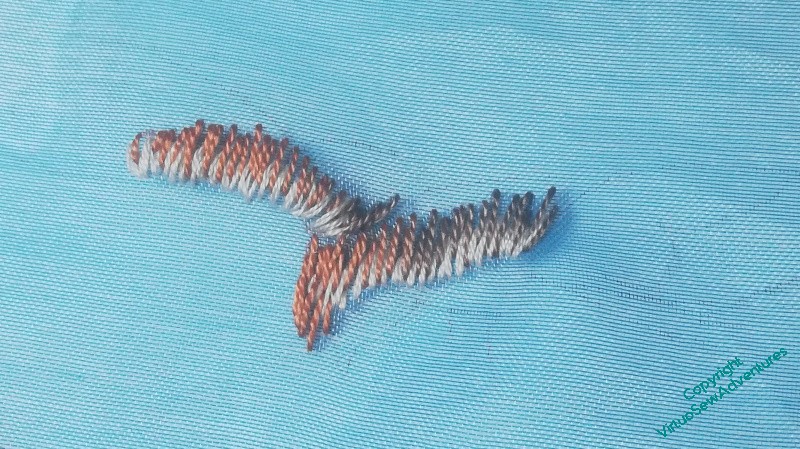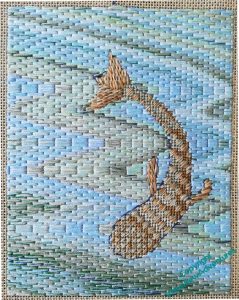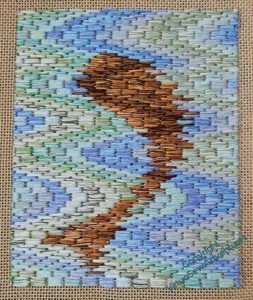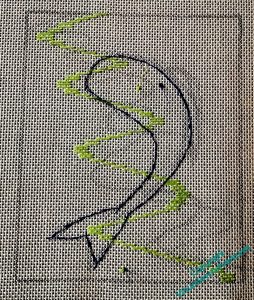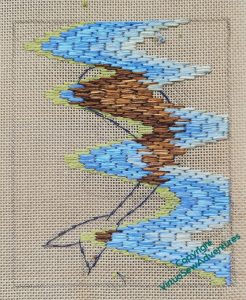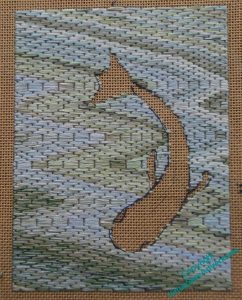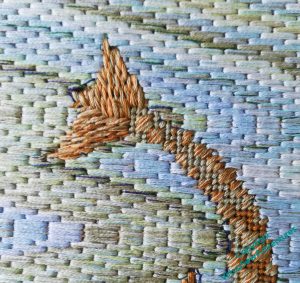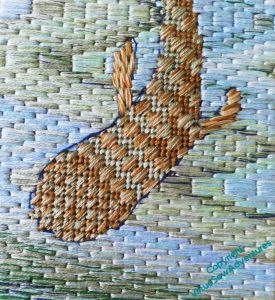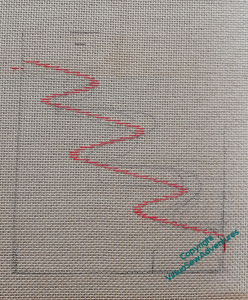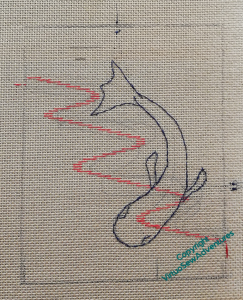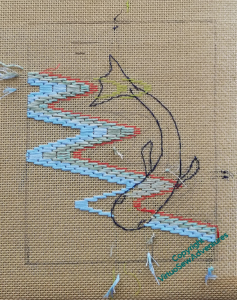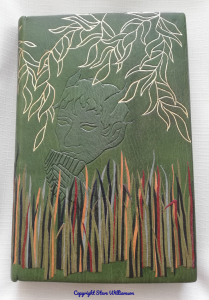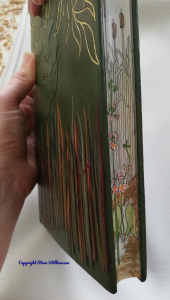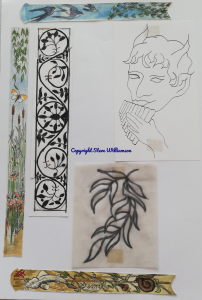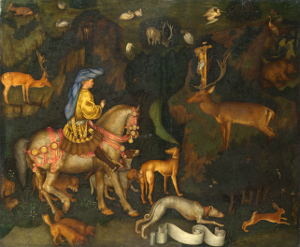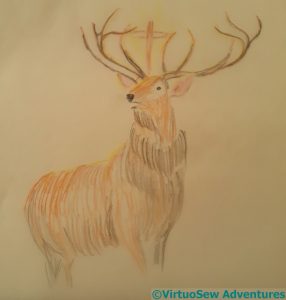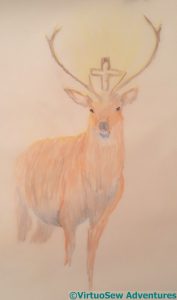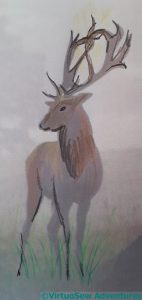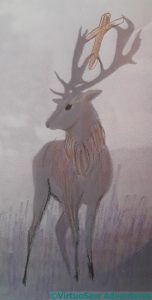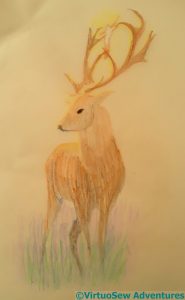Tag: Vision of Placidus
Working on the Brockis
You may or may not be able to see that there’s a drop-shadow effect in these photos – I learned from the mistake of the hawk, as I mentioned, and mounted the green gauze on a frame before I started. I rather like the result when I set it down for photography, and it gives you a much better sense of the view I got as I stitched.
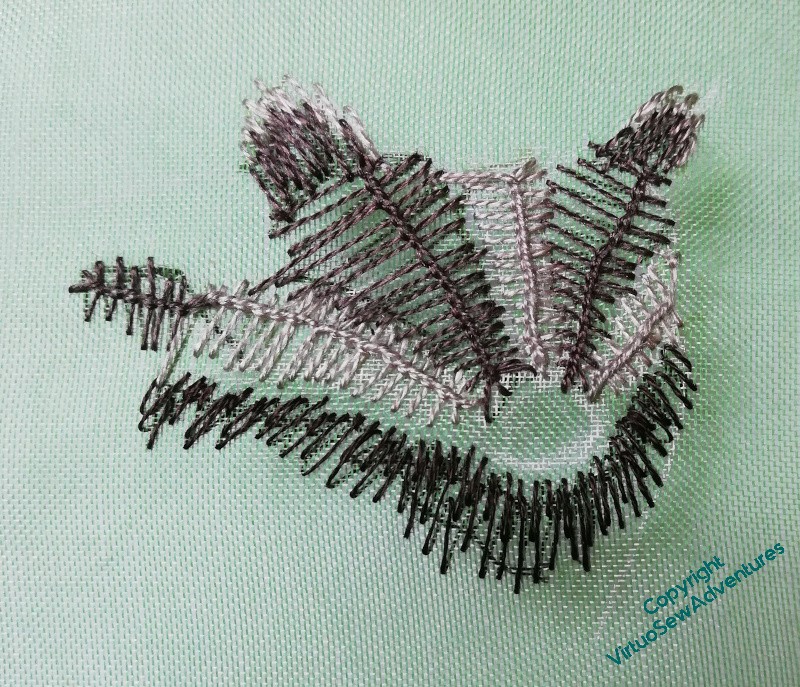
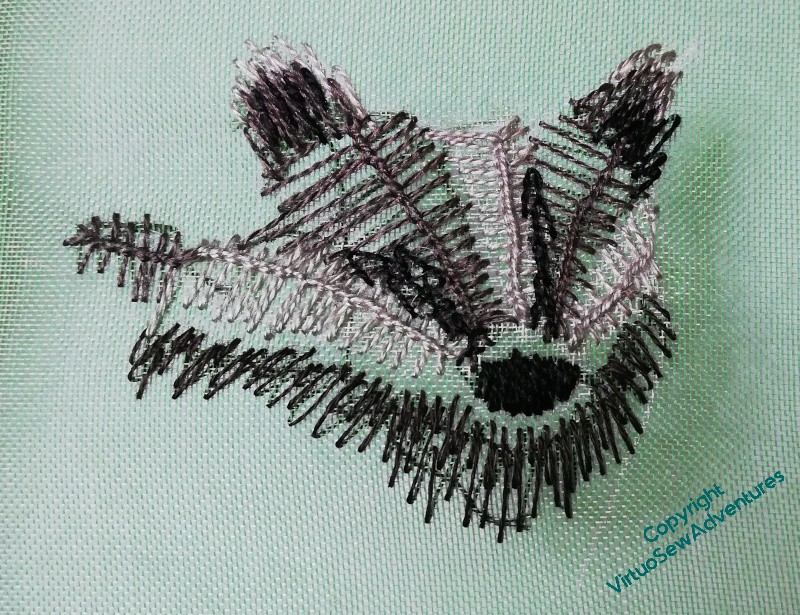
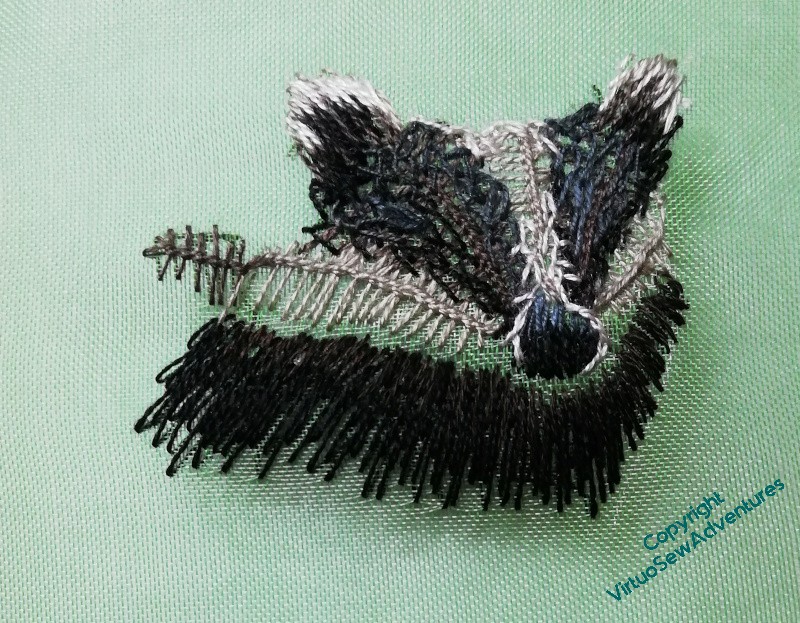
Ordinarily, I would be very concerned about working on gauze – the hawk is virtually satin stitch to ensure there’s nothing grinning through the gaps – but I have a feeling that this is going to evolve as I work on it. Regular readers will know by now that if I’ve convinced myself that something is necessary for the effect I want to achieve, I grit my teeth and do it, even if I don’t think I’ll enjoy it – although by the alchemy of Achieving What I Aimed For, it’s amazing how often I do in fact enjoy it!
My brockis is going to be peering out at the main scene from behind a tree, so he’s going to be on the ground, in amongst the undergrowth, and probably backed by darkish fabric and stitch. That being the case, gaps in the stitching might in fact enhance the sense of depth in the whole assembly. I want him to have rather rough fur, so he’s not going to be satin stitch, is he?
So my brockis is made, again, purely freehand, referring to the photo for guidance, but simply in layers of stitching. I’ve used silk, cotton, and linen threads, and a tangle of Vandyke stitch, Cretan Stitch, feather stitch and alternating twisted chain stitch. The silk came from the same stash as the silk I used for the hawk, the linen is a Stef Francis yarn I bought for the Dreams of Amarna that never quite worked in any of the projects, and the cotton is ordinary stranded cotton, but only single strands.
I’m rather pleased with him.
Another observing animal for Placidus
Elizabeth Goudge’s book “The Herb of Grace”, which gave me the idea for Placidus, is set in a pilgrim inn near to some ancient woodland, and in her writing she regards the trees and animals of that woodland as very much part of the world the family inhabits. She wouldn’t, I’m sure, have considered herself an environmentalist, but only because she probably couldn’t imagine considering herself as other than part of the natural world. Certainly the fictional fresco maker she imagines would have done so.
My reboot over the period between Christmas and Epiphany has suggested that since I want to have a welter of animals observing the scene, maybe I should just start on them. Once I have enough to make a start, that might help me with the trees, the rocks, and the stream. Then Placidus with his horse and hounds, and the stag will have somewhere for their drama to take place.
It was the Herb of Grace that told me of the word “brockis” as an old name for a badger, and over on Patreon, the writer Anne Louise Avery has a character she calls “Grey Brock”, whose adventures are often illustrated with a photo of a badger paying very close attention. I’ve used that photo as my starting point, and sketched my brockis on some green gauze (on a frame, this time!) using a white gel pen.
And can we just pause there to celebrate the fact that I sketched this, freehand, on a difficult surface with an indelible pen, and ended up with a recognisable badger? Even last year, I don’t think I’d have managed it!
The animals are going to be quite experimental, I think. Certainly there won’t be a lot of long and short stitch. I want a lot of rough and ready texture and an excuse to experiment.
So the first layer of my brockis is actually vandyke stitch in a middling creamy beige that will help, I hope, to create some depth in his fur.
Hawk in a clear blue sky…
A good, optimistic start to the creative year, here, with my first bit of stitching for Placidus – who’s only been in the planning stage for a decade or so!
You will see from the progress pictures that I was absolutely rocketing along the edge of catastrophe curve here, very little planning, and just alternating staring at my source and stitching. This is the way I tackled Ankhsenspaaten, and a few other pieces, and it’s very much the way I prefer to paint. But it’s highly uncertain as to success, and I may come back in a few years and try again.
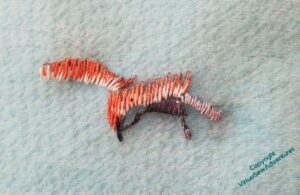
Clicking through will show you how little guidance I’d put on the gauze, and how little it showed once there. Furthermore, I was in such a fever of impatience to start that I used neither frame nor hoop, working in the hand instead. I won’t do that again.
(Until next time I do it..)
I’ve mostly used silk perle, which is lovely, and the particular bundles I’m using I’ve had in my stash for decades. I use it, but it’s quite fine, and until recently I’ve preferred to work with rather more solid materials. We also discovered, when my grandfather’s carer boil washed a tray cloth I’d embroidered for him, that the colours aren’t washfast. Not a problem in this case: a panel hanging on the wall, using a wild mix of materials, is unlikely to be boil washed unless by someone deliberately seeking to destroy it.
In the meantime, if it is to work in the eventual piece, it will need to be savagely blocked or pressed to get the crinkles out of it – not because my tension was tight, but because the stitching is filling up the spaces between the fabric threads and making them move and misbehave.
I don’t mind – I’ve already pinned it out, and I’m just so pleased to have made a start on the Vision of Placidus at last!
Update: I showed this to The Australian, who immediately started singing the Hawthorn team song (Australian rules football). Go, Hawks!
Rebooted!
Having a Twixmas project has become part of my year for more than one reason. Firstly because usually I have to hide away my main project, as the table I work beside takes the Christmas tree. But secondly, and in some ways more importantly, it helps me “reboot” myself. Last year in particular, I ran out of “me” before I ran out of year, by quite a few weeks, and sitting quietly doing something I didn’t have to do any planning for turned out to be a proper reboot.
Because I’ve come up with ideas for making progress with Placidus, who’s been losing forward momentum for quite a while, as well as having ideas for another embroidered coat..
Placidus first. We’ve been remembering the description of the fresco in “The Herb of Grace”, and it’s slightly mad, the characters of Placidus, his horse and dogs, and the stag all a bit big and out of scale with the forest, and with little vignettes of animals in the spaces in the canopy.
Placidus had stalled because I’d got caught up in having the design planned out before I started. It’s going to be a big design, and for all my drawing and design skills have improved enormously over the years, a very taxin one. So, the reboot is to do what I did, in fact, with Amarna – start doing fragments that will be part of it, and worry about assembly when I get there.
Shortly after having that thought, I found myself watching a documentary in which Hamza Yassin was on the track of Britsh birds of prey, and remembered a bit of blue gauze I have in my stash.
Well, now.
So I started with pausing the documentary and taking a few photos of one of the hawks. Then I found the gauze and drew a very light outline in one corner of it. I’m going to be freestyling this one – part of continuing the reboot and reminding myself of my True Love in stitching.
Fishy Lessons
So now, having finished my two fishie experiments (there may have been a third in the pipeline, but I’ve forgotten what it was!), what can I say I’ve learnt?
First, canvaswork stitches against the freeform bargello. There’s a sort of stillness, almost a static quality to this fish, in spite of the flowing bargello.
The bargello works well, although now I look at it, I’ve not managed to keep it flowing from top to bottom. And it was remarkably difficult to keep track of the pattern across the fish.
The second fish was an attempt to suggest the broken outline of an object seen through the interface between air and water. So this time, the pattern of the bargello ran through the fish, and I had to decide at each edge whether to stitch in the fish colour or the water colour. The pattern runs more successfully from top to bottom of the piece, but the whole thing looks a lot more active, maybe too active.
I think the colours are a bit too bright and swimming pool-like, but as these are experiments, using stash, I’m not too concerned about that. What does concern me is that even after these two, fairly substantial pieces, the appearance of a particular blend of threads as it was stitched was sometimes a surprise. It will be hard to pick the right colours to use if I can’t rely on my imagination of how the thread will stitch up.
So, I don’t know whether I will use this idea for the borders of Placidus, but I’ve got plenty to think about, haven’t I!
Episode 69 of Slow TV Stitchery is now live, on talking projects, the development of musical taste, and the challenges of suggesting wind over the water.
A Second Fishy Experiment
So, having learnt enough to be encouraged by the First Fishy Experiment, I embarked upon my Second Fishy Experiment.
Again, I drew out the borders, tacked the edges of the fish, and drafted the line of the bargello pattern using coloured sewing cotton. You can see how many times I thought and rethought what I was going to do in pencil beforehand!
I’m using the same bit of leftover canvas, so again my threads will be blended using nine strands of stranded cotton, although I’ve added a bit to the fish by using a variegated metallic machine embroidery thread as one of the strands.
This time the experiment is to see whether I can create something of the effect of looking through the surface of water at the fish. That means making the edges of the fish uneven, rather than crisp, so rather than an entirely different set of stitch choices for the fish, and compensation stitches everywhere, I will use the same stitch pattern throughout.
That in turn means that as I approach the edge of the fish on each row, I have a decision to make about whether to use the water colour or the fish colour for the stitch that straddles the edge. Fortunately, this isn’t the sort of decision I find unnerving or difficult to make, and even here, I think you can see that this idea is rather likely to work!
I realise that the post about starting the Second Fishy Experiment somehow managed to end up well behind the videos. Episode 57 of Slow TV Stitchery is now live, in which we muse on the effects of blending colours in the needle, the demise of Scottish pearling, and the final “It depends!” moment.
First Fishie Experiment Finished…
The background of freeform Bargello was rather entertaining to do. Working using nine strands of stranded cotton allowed for some subtlety in the colours, combining various blues and greens in different proportions and shading them into one another, sometimes gradually, sometimes stongly. I was surprised, sometimes, when progressively adding a particular colour, to find that it didn’t make as much difference as I expected – but this is why we experiment!
Once I came to the Fishie himself, there was a bit of puzzlement. I wanted to have a different pattern for the head, the fins and tail, and the body. I wanted a vaguely “scale-like” pattern, and I wanted to make sure that the stitches were at a different orientation to the water.
I settled on Moorish Stitch for the body, Mosaic Stitch for the head, and Encroaching Gobelins Stitch for the fins and tail. And I left in the tacked outlines. They only show in a few places, and I think they give the impression of sketched lines, which is quite suitable for an exploratory piece. I’ve also left out the eyes, since I’m looking from above.
Looking at it now, I’m pleased with the sense of flowing water that the bargello nearly creates, and the fish is interesting, but maybe not entirely successful. Some of the edges and joining points are a little clumsy – but that may be because this is an experiment, thrown together to see what I learn.
I’ve had at least one idea for another fishy experiment, so you will be seeing more of this sort of thing…
And indeed, Episode 54 of SlowTV Stitchery describes the beginning of the Second Fishy Experiment, in which I begin a second fishy experiment, this one attempting to give the impression of the fish seen through water, making some slight changes to the form of the freeform bargello, and anticipating tussles with my very leftoverish leftover thread.
An experiment for Placidus
Bear with me, please!
At the moment, the idea for The Vision of Placidus is that the main picture – the encounter between Placidus and the Christ/Stag – will be framed with a depiction of denizens of the natural world – underwater creatures in the lower section, bulrushes and dragonflies in the upright sections, and birds in the upper section. I’ve been thinking of putting the symbols of the Evangelists in the corners, to obviate the necessity of dealing with getting the design around those corners.
However, what I’ve not yet sorted out is the technique I might choose to use. This is going to be an experiment to see whether using canvaswork – a sort of freeform Bargello with embellishments – will create a pleasing effect.
I was really very pleased with how quickly this came together when I began thinking about it. The red line is a guide for the freeform Bargello, representing the current in a stream, and the fish is simply there to help me test how to deal with the boarders between the flowing background and the motifs.
That might be easiest to achieve if I worked the fish, and then added in the background, but if I do that, I think it will be nearly impossible to place the background correctly on the far side of the fish. So this time, I’m doing the background first, putting in the stitches across the fish in sewing cotton, as a sort of “draft”.
I’m using stranded cotton, separated and combined to create blended shades. As it turns out, six strands are not quite enough for full coverage, so here I am using nine.
Episode 51 of Slow TV Stitcery is now live, including a comparision of bone and steel laying tools, consideration of two possibilities to experiment with for Placidus, and thoughts about taking sagas seriously.
Thoughts on the Next Big Project
I’ve been continuing to think about The Vision of Placidus, but part of my inspiration has shifted, from the mille fleurs background of the the Unicorn Tapestry, to the edge-painting my mother did for a Fine Binding she made of The Wind In The Willows.
An edge painting is exactly what it says: colour added to the edge of the codex of a book, often in patterns or pictures that relate to the story or theme of the book.
So, although there may still be animals in mille fleurs fashion in odd spaces in the picture, I’m also planning to design a border. Underwater will be shown below the main image, just above the water surface on the vertical edges, and the sky on the upper border.
This design sheet shows the design of the edge painting for the book, to give you some idea of what I am thinking about.
There will be a pike underwater, I’m sure, and the vertical borders will be where the kingfisher, and maybe some dragonflies, can go. I might spend some time looking at the symbolism of various animals, just to make sure that the right creatures show their faces.
The corners will probably have the symbols of the Evangelists, but at the moment I’m not sure in quite what style..
In other news, Episode 40 of SlowTV Stitchery is now live, in which we move to the Christmas playlist, discuss the tension between economy and adequate coverage, and express surprise at the amount of real history one can learn from well researched fiction.
Thinking about the stag for the Vision of Placidus
I’ve already mentioned that, although I have more yet to do on the Dreams of Amarna, I have little thoughts, now and again, about my plans for the next Really Big Project, the Vision of Placidus, inspired by Pisanello’s “Conversion of St Eustace”, Elizabeth Goudge’s “Herb of Grace”, my mother’s fine binding of “The Wind in The Willows”, and the kingfisher I saw at Flag Fen. Oh, and the “Chasse a la licorne” tapestry in the Musee de Cluny.
The Stag with the crucifix in his antlers is going to be the major character, and while I know I’m tearing into a genius of the past, I think Pisanello’s stag is a bit too tame for the story…
My first thought was to start from Sir Edwin Landseer’s Monarch of the Glen. After all, he’s full of personality and presence, and a recognisable figure to add to the layers of meaning and reference. But no, I think the crucifix won’t settle well into the antlers, and the pose isn’t quite right, either….
Then I spent more time rummaging online for pictures of stags, and came up with another to try. I like the challenging, direct stare of the pose here, but it puts the onlooker in the position of Placidus (according to the stories, he took the name “Eustace”, or more probably a Latin variant thereof, when he became a Christian), and I want Placidus to be in the picture. That said, he was a second century Roman, and I’m intending to dress him in florid fourteenth century dress, so don’t expect too much accuracy…
My next thought came from a book about the landscapes of Capability Brown that I bought for my cousin for Christmas. I’ve told her about the plans for Placidus, and she opened her gift, leafed through it, and then turned the book to me and said “Would this help?”
This is by no means the first time my cousin has helped me with design planning – it was talking to her that enabled me to crystallise the ideas for the Dreams of Amarna – and I like the photo enough to have three attempts at it. I still don’t think I’ve got it right. That said, all of these sketches have allowed me to think, not just about the pose, but about how I will use my threads to create the effect I want, of the illumination in the scene emanating from the crucifix.
A good use of time, even if not a stitch was set!

